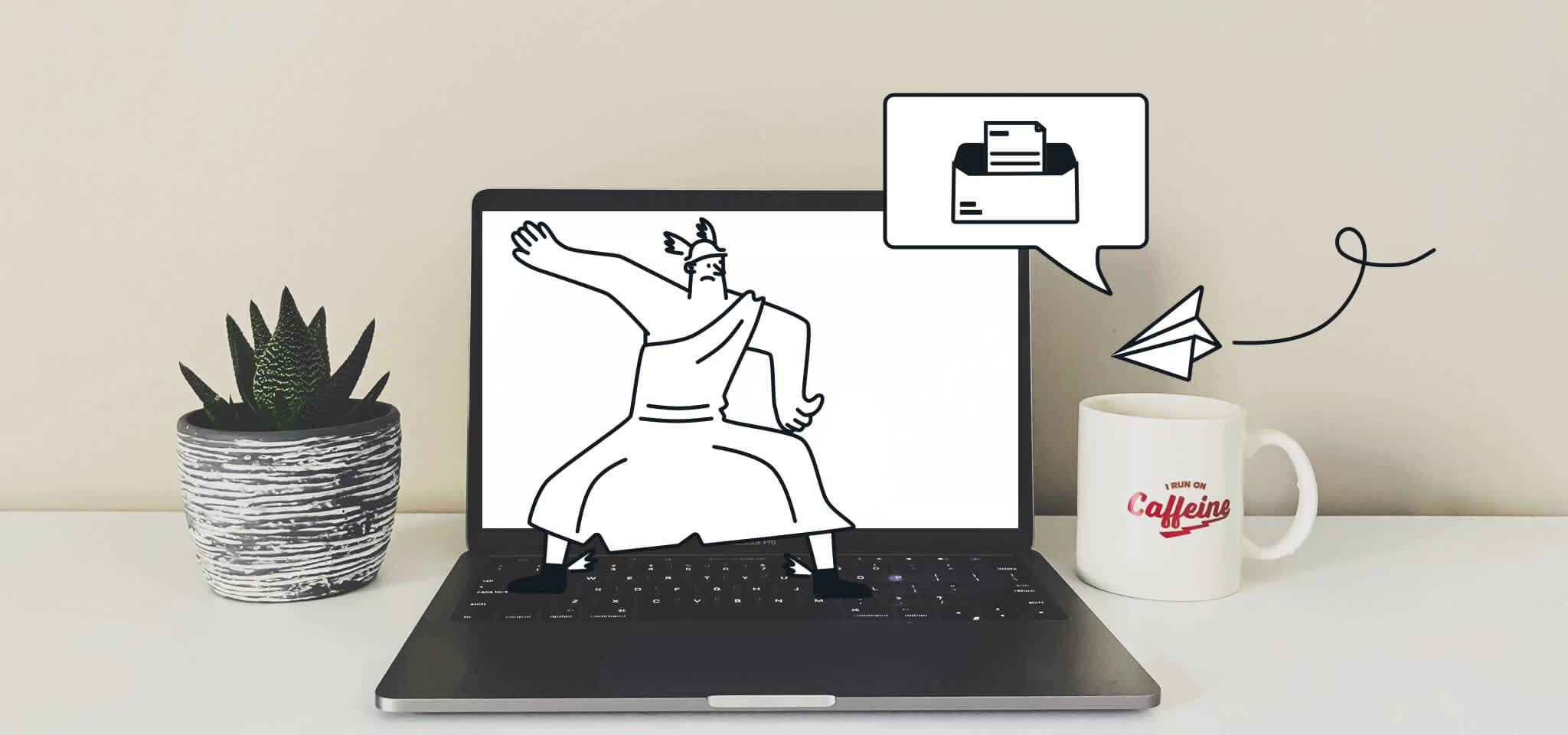Deliverability
Email throttling: An optimization guide
Email throttling is like trying to accelerate with the handbrake on. We’ll run through reasons why inbox providers often apply the brakes to email campaigns. Then, we’ll run through strategies to prevent email throttling in the future.

PUBLISHED ON
Have you ever started an email campaign, only to receive error codes time and time again? The doomed “message not sent because of server error”? It may not seem harmful, but this is throttling – and no, we’re not talking about the Harley Davidson kind of throttle (vroom vroom). We’re talking about email throttling.
Want to know more? Grab your leather jacket, and let’s get started.
Table of content
The receiving server doesn’t recognize your IP address
The receiving server doesn’t have any open ports
The recipient’s mailbox is full
You’re marked as spam
Segment your email lists
Send your emails earlier
Clean your databases
Send a small number of emails to start
Improve your sender reputation
What is email throttling?
Email throttling is one of the minor components of email deliverability. This technique consists of carefully adjusting the speed of email/campaign sendings, respecting the filters of major internet service providers (ISPs) and receivers across the globe.
Throttling, at its core, is essentially rejection – unpleasant for everyone involved. The average ISP and receiver use unique thresholds to control email flow and filter out bad emails. As is the case with email deliverability, it’s a great idea to surround yourself with experienced folks who can redefine delivery speed to various ISPs and receivers.
How it works
The technique involves configuring several different parameters:
The number of emails sent per minute or hour
The number of SMTP connections per minute or hour
The number of emails sent by each connection
According to ISPs and webmails, these parameters can be used simultaneously or separately. Depending on the email platform you use, you may not always have the opportunity to set these parameters yourself (which could be a good thing). Here are some scenarios:
The email sending platform allows you to configure the parameters yourself.
It’s impossible to optimize the parameters – they are configured by default.
The parameters adjust automatically according to sending conditions.
Reputation and volume
For some ISPs and webmails, the number of accepted connections and the email volume limit may vary depending on your reputation and the number of emails you send. For example, if you suddenly increase the number of emails you send, certain ISPs and webmails will block a portion of your emails.
To detect this temporary blockage, if your provider doesn’t do it for you, you must analyze the SMTP error messages like: “Too many connections from your host.”
How do you know if your emails are being throttled?
Your emails are throttled when you receive detailed bounce messages from ISPs regarding your sending frequency. If you exceed the threshold set by your email service provider (ESP), your emails will be bounced back to you. You won’t connect to the server and will receive an error code, depending on which throttle cause has occurred. The throttle is likely because you sent too many emails in a short period of time, but there are a few other reasons you might receive a bounce.
5 causes of email throttling
Email marketing is one of the most effective drivers of digital traffic. It’s worth taking the time to learn how email throttling can change your marketing campaign. It doesn’t matter what type of email program you use – there’s always a chance you’ll experience throttling. Though this rejection is usually temporary, it slows down your campaign and gives you extra work.
The receiving server doesn’t recognize your IP address
Spammers will flood a receiving server with emails in quick succession rather than sending them over a period of time. The server might think you’re a spammer if you don’t have an established sending reputation.
The receiving server doesn’t have any open ports
You’ll receive an error code if the receiving server is closed. An open port is a TCP port number customized to receive data packets. A closed port rejects connections and ignores data packets because it doesn’t know which application it needs to open the package.
The recipient’s mailbox is full
There isn’t much you can do in this situation. The end user’s mailbox is full, and you’ll likely experience a soft bounce until they clear some room. This situation may lead to multiple bounced emails, which isn’t worth your time or effort.
You’re marked as spam
Though it may hurt, some people might not like your emails. If they’ve marked you as spam, you’re going into the spam folder. The server won’t block you until they see how your other recipients behave. Some people might unsubscribe from your emails. It may seem surprising, but email has a carbon footprint, and continually sending emails to someone who doesn’t want them does nothing good for the environment.
5 strategies to prevent email throttling
Every ISP has a threshold when it comes to delivery. Once they trust you as a reputable sender (and not spam), you’ll likely experience less throttling. Using a tool like Mailjet’s Email Automation helps prevent throttling, especially when working with a smaller team or building up to a larger campaign. Use a few strategies to ensure you’re making the most of your campaign.
Segment your email lists
A dedicated IP for both your marketing and transactional emails is an excellent way to increase your sending reputation. If they’re separate, then you’ll receive fewer total bounces. When you use a dedicated IP, you’re the only one responsible for its reputation. Split your email lists by domain or your databases into batches to reduce the likelihood of throttling.
Send your emails earlier
If you send your emails ahead of schedule, you won’t have to catch up later. Give yourself enough time to follow your delivery rate, and don’t send a high volume of emails simultaneously. You’re less likely to be throttled this way.
Clean your databases
Rub-a-dub-dub, give those email lists a scrub. Your sending reputation will improve if you delete any inactive, invalid, or expired email recipients. Though the inactive addresses might not increase your open rate with no user on the other end, you can use them in your next re-engagement campaign. Remove recipients from your email lists if they continue to bounce.
Send a small number of emails to start
A warm-up process is necessary to maintain a good sender reputation with ISPs. Your reputation is integral to your email messages appearing in your recipient’s inbox. It’s critical to follow a warm-up process to increase your email sending gradually. The warmer the beginning, the less likely you’ll be throttled.
Improve your sender reputation
If your email lands in someone’s spam folder, expect low open rates, click-throughs, and view times. Your reputation is always at stake.
But once you have some sending experience, email providers and recipient systems will begin to trust you as a sender. Your IP address will then be at full capacity, allowing you to send more emails.
Before starting any email marketing strategy, make sure you learn about email marketing audits to grow your reputation.
Throttled vs. deferred email
Though it might seem like all throttling is the same, deferrals are a different beast. When the sending server rejects a throttled email, you’ll need to retry because the delivery attempt has not happened. But when the receiving server rejects a deferral email, the delivery attempt does occur, but the recipient server hasn’t accepted it. If this happens, the sending server will try another email delivery later.
Some ESPs put throttling and deferrals under the same umbrella, but there’s a difference. An email escapes throttling when it goes from the sending server to the receiving server, but it can still face deferral. An ESP may promise to send a staggering amount of emails, but it isn’t up to them. ISPs limit the sending volume, so make sure you’re using a service that delivers – no pun intended.
Mailjet adapts sending speed and the number of simultaneous connections to optimize the deliverability of your emails in real-time. In this way, you don’t have to worry about this aspect of your email campaigns and benefit from our deliverability team’s experience.
Wrapping up
Applying these strategies to your next email marketing campaign over a specified period will decrease throttling and improve your sending reputation. Rejection is never any fun, but it’s up to you to get back in the proverbial saddle – whether on a motorcycle, horse, or email. Send like the wind, cowboy – go burn that email rubber.
Email Deliverability Services
Landing in the inbox is a challenge: 21% of legitimate emails are either lost or marked as spam. Improving deliverability is a crucial factor in successful email campaigns. Our Deliverability Experts are here to help you reach the inbox and get the most out of our worldwide relationships with mailbox providers.







